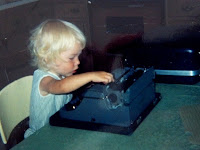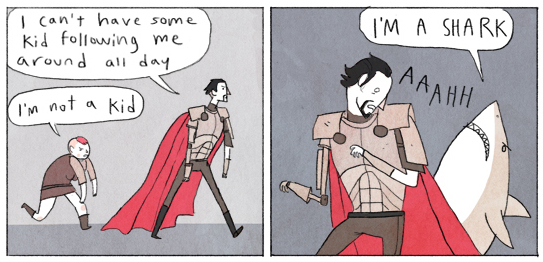During National Novel Writing Month (NaNoWriMo), thousands of people work on
writing a rough draft of a novel in the month of November.
Why? How could you possibly
write an entire novel (defined, for the purpose of this month, as 50,000 words
or more) in a single month? More importantly, how could you possibly write a good novel in a month?
Writing a good novel is not the point. Maybe writing poorly
sounds like a bad idea, but taking on this intensive challenge for a month has
several advantages. The time pressure forces you to put aside your editor and
critic hats and instead focus on getting words on paper. This helps some people
avoid the insecurity that can come with starting a new project, or the
temptation to endlessly edit the first few chapters instead of moving forward. Writing
fast quickly gives you material to develop.
It also encourages you to schedule writing time – plenty of
it, every week. It’s easier to give up TV, reading, and other hobbies for a
single month. It’s also easier to get family members to adjust their schedule
to yours if you are requesting a favor for a month, not forever. (You may even
discover that your family, and the world, can function with less of your
attention than you thought.)
So NaNoWriMo can get you jumpstarted on idea, give you a
big, messy draft to work with, and help you establish new habits Even if you
can’t devote the same amount of time to writing after November, maybe you can carve
out some time every week.
Finally, the challenge provides a strong sense of community.
You can network with other writers, encourage each other, and find inspiring
blog posts or helpful tips to keep you moving for your project. (Just don't
spend all your time reading about writing and talking about writing, rather
than actually writing.)
Are You in?
The first step is establishing your own goal. Maybe you
don't want to attempt the official goal of 50,000 words. For a middle grade
novel, 30,000 words may be more realistic. That's *only* (?) 1000 words a day
for the month! (Of course, you have to consider whether you can actually write
seven days a week, and if you're in America, don’t forget Thanksgiving break.) Or
maybe there's a cool that's better for you – writing for 15 minutes every single
day, or making progress on a novel you've already started.
Making the Most of an
Idea
If you want to be ready to write a novel in November, it’s
best to start brainstorming and planning in advance. Even if you are a
"pantser" who prefers to dive in and figure out your story as you go,
you might avoid some time staring at a blank screen by brainstorming your basic
idea and a few things that could happen. If you're a plotter, you might want a
more developed plot outline before you begin.
Here's a condensed excerpt from my book Advanced Plotting to help you get started.
A story has four main parts: situation, complications,
climax, and resolution. You need all of them to make your story work.
The situation should involve an interesting main character
with a challenging problem or goal. Even this takes development. Maybe you have
a great challenge, but aren’t sure why a character would have that goal. Or
maybe your situation is interesting, but doesn’t actually involve a problem.
For example, I wanted to write about a brother and sister
who travel with a ghost hunter TV show. The girl can see ghosts, but the boy
can’t. That gave me the characters and situation, but no problem or goal. Goals
come from need or desire. What did they want that could sustain a series?
Tania feels sorry for the ghosts and wants to help them,
while keeping her gift a secret from everyone but her brother. Jon wants to
help and protect his sister, but sometimes feels overwhelmed by the
responsibility. Now we have characters with problems and goals. The story is
off to a good start.
Tips:
·
Make sure your idea is specific and narrow.
Focus on an individual person and situation, not a universal concept. For
example, don’t try to write about “racism.” Instead, write about one character
facing racism in a particular situation.
·
Ask why the goal is important to the character.
The longer the story, the higher the stakes needed to sustain it.
·
Ask why this goal is difficult. The level of
difficulty will vary depending on the length of the story and the age of the
character, but the task should be believably hard.
·
Even if your main problem is external, give the
character an internal flaw that contributes to the difficulty. This adds
complications and also makes your character seem more real. For some internal
flaws, see the seven deadly sins: lust, gluttony, greed, sloth, wrath, envy,
and pride.
·
Test the idea. Change the character’s age,
gender, or looks. Change the POV, setting, external conflict, internal
conflict. Choose the combination that has the most dramatic potential.
Building the Middle
If a character solves his goal easily, the story is boring.
To keep tension high, you need complications.
Try the “rule of three” and have the main character try to
solve each problem three times. The first two times, he fails and the situation
worsens. Remember: the situation should worsen. If things stay the same, he
still has a problem, but the tension is flat. If his first attempts make things
worse, tension rises.
This can play out in many ways in novels. In my first
Haunted book, The Ghost on the Stairs,
I made sure each ghost encounter felt more dangerous. As Tania tries to get
closer to the ghost in order to help her, Jon worries that she will go too far
and be injured or even killed. With enough variety, you can sustain this kind
of tension indefinitely (witness the ongoing battle between Harry and Voldemort
in the seven-book Harry Potter series).
You can worsen the situation in several ways. The main
character’s actions could make the challenge more difficult. In my children’s
mystery set in ancient Egypt, The Eyes of
Pharaoh, a young temple dancer searches for her missing friend. But when
she asks questions at the barracks where he was a soldier, she attracts
dangerous attention from his enemies.
The villain may also raise the stakes. In my Mayan
historical drama, The Well of Sacrifice,
the main character escapes a power-hungry high priest. He threatens to kill her
entire family, forcing her to return to captivity.
Secondary characters can cause complications, too, even if
they are not “bad guys.” In The Ghost on the
Stairs, the kids’ mother decides to spend the day with them, forcing
them to come up with creative ways to investigate the ghost while under her
watchful eyes.
Finally, the main character may simply run out of time. At
her first attempt, she had a week. At her second attempt, she had a day. Those
two attempts have failed, and now she has only an hour! That creates tension.
Tip: For each
turning point in the story, brainstorm 10 things that could happen next. Then
pick the one that is the worst or most unexpected, so long as it is still
believable for the story.
Don't worry if you wind up with a big messy draft. That's
what National Novel Editing Month (NaNoEdMo)
in March is for. You even get to rest for a couple of months before doing that.
Still, if you've developed some good writing habits… try to
keep them going!
Chris Eboch’s novels for ages nine and up include The Eyes of Pharaoh, a mystery in
ancient Egypt; The Well of Sacrifice,
a Mayan adventure; The Genie’s Gift,
a middle eastern fantasy; and the Haunted series, about kids who travel with a
ghost hunter TV show, which starts with The
Ghost on the Stairs. Her writing craft books include You Can Write for Children: How to Write Great Stories, Articles, and
Books for Kids and Teenagers, and Advanced
Plotting. Learn more at www.chriseboch.com
or her Amazon page,
or check out her writing tips at her Write
Like a Pro! blog.




































